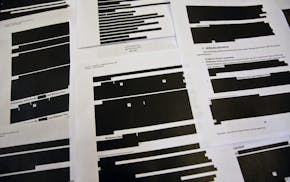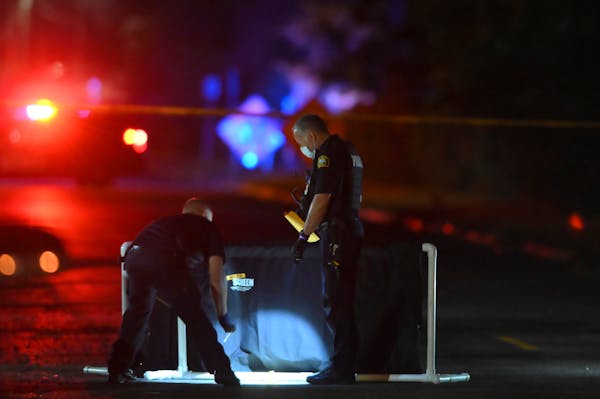With 2021 coming to a close, Minneapolis is approaching a grim milestone.
The city recorded its 96th homicide this week, one shy of the record set in 1995.
A surge in gun violence in 2021, especially in the city's most diverse and lowest-income neighborhoods, fueled the second straight year of what has become Minneapolis' deadliest period in a generation. The homicide count this year surpassed 2020's 84 reported killings — an increase many prayed was an aberration — and doubled 2019's.
The killings tell only a fraction of the story of gun violence playing out on the streets, and do not capture the reckless non-fatal shootings, like that of a grocery store clerk during a robbery in the Bryn Mawr neighborhood Thursday morning. Police and paramedics have responded to nearly 500 shootings this year, and more than 600 people have been treated for gunshot wounds in Minneapolis hospitals, according to data published by the Police Department. Reports of gunfire are up by every available metric. And armed carjackings have nearly doubled over the past three months compared with last year at this time.
It's not just Minneapolis. St. Paul hit its highest homicide count in history weeks ago. Chicago surpassed 800 homicides this year, for the first time in a quarter-century, according to WBEZ, the city's public radio station. While 2021 numbers are still being tabulated, major cities across the country appear to be caught in a similar bleak reality.
"This is a national increase," said Ames Grawert, who studies crime data in America as senior counsel for the nonpartisan Brennan Center for Justice. "This is not about any single city. This is not about any single policy."
According to preliminary numbers from consulting firm AH Datalytics, the homicide count increased 7% in the country's largest cities this year compared with 2020.
In Minneapolis, homicides rose by about 14%, according to Star Tribune data, which include people killed by law enforcement.
An analysis of the data found:
- Shooting was the cause of death in the vast majority — 78 — of the killings.
- Minneapolis is predominantly white, but non-white and Hispanic people made up 86% of victims when race was known. In 75% of killings, the victims were Black or Somali.
- The average age of victims was 30. About one-fifth of the victims were teenagers or younger, with five younger than a year old or still in the womb.
- Police have identified a suspect in about half the shootings, with an average suspect age of 32, and the youngest, 15.
- More than half of the killings occurred in public places, like bars, convenience stores, alleys or streets.
Minneapolis police did not respond to an interview request or a series of questions.
Searching for answers
The escalation in violence started in June 2020.
At the time, the COVID-19 pandemic had smacked Minnesota into a stupor, throwing the economy into a state of uncertainty, disrupting government services and bringing social life to a full stop. Americans, meanwhile, had rushed to gun shops in record numbers. Political division had reached a record high as the country headed into a contentious election.
Then came the viral video showing a Minneapolis police officer murdering George Floyd.
Those who study crime trends say there is no single source driving the shootings — there is still debate over what caused the crime spike and decline in the 1990s — and it's likely that all of these factors and more have played some role in what's happening now. But the killing of Floyd created residual effects that greatly exacerbated street violence, said Thomas Hargrove, founder and chairman of the nonprofit Murder Accountability Project.
"We have a great deal of tinder in America for homicides," said Hargrove. "But we didn't have ignition of the homicide fire until George Floyd's murder. And that was when everything went south."
Law enforcement lost the already fractured trust of communities they serve, said Hargrove. Police spent their shifts responding to civil unrest, instead of working neighborhood beats and fulfilling their role as societal "guardians." Officers quit en masse, straining resources as the need increased.
In June, reports of gunfire rose about 220% from June 2019, accompanied by a wave of homicides and assaults.
"It was just the most vicious of vicious cycles last year, and it hasn't healed magically yet," said Hargrove.
Before June 2020, violent crime had been in a prolonged low period in Minneapolis. Homicides ebbed and flowed, but trended down since the late '90s. The city is more populous today, so the homicide rate per 100,000 is still lower than in 1995, when murders peaked. But the recent leap in killings has manifested dramatically quicker, showing no signs of slowing.
The distrust in the criminal justice system — reflected in the failed push to replace the Minneapolis police — is similar to the sentiment toward law enforcement when violence spiked in the '90s, said Will Cooley, a Metropolitan State University history professor who is researching that deadly "Murderapolis" era. When people see police as antagonists or untrustworthy, they're less likely to call 911 or cooperate with officers, he said.
"Any criminologist will tell you that when legitimacy goes down, people take matters into their own hands," Cooley said.
In 2020, Americans turned to guns.
Gun sales shattered every record during the pandemic, with about 21 million purchased in 2020 alone, including more than 13 million handguns, according to data collected by the Trace, a website dedicated to reporting on the gun violence.
Some of these weapons landed on the streets.
In fiscal year 2021, ending in September, federal investigators in the Midwest seized 1,021 illegal guns — up from 611 the previous year, according to data provided by the Bureau of Alcohol, Tobacco, Firearms and Explosives (ATF).
The ATF, which embedded with Minneapolis police last year to fight gun violence, has recorded a rise in gun thefts, particularly from vehicles, said William J. McCrary, the ATF's special agent in charge of the St. Paul field office. The agency has also seen a rise in "straw purchase" schemes, in which a legal buyer acts for a third party, he said.
This week, a Twin Cities woman pleaded guilty to buying 62 guns in a single month — and nearly 100 in a year — on behalf of black-market buyers.
'The smoke hasn't cleared'
About three-quarters of the homicides so far have taken place in neighborhood clusters within south Minneapolis' Third Precinct and the Fourth Precinct, which encompasses the North Side. Central Minneapolis in the First Precinct accounted for most of the rest, leaving many neighborhoods unaffected day to day by the violence, especially in the wealthiest parts of the city.
This may reflect the starkly different lived experiences of Minneapolis residents over the past two years, said Chris Uggen, a University of Minnesota sociology and law professor.
Under lockdown conditions, some young people stayed home with their parents, subject to greater daily supervision than normal. "But there's a subset of kids who had none of that — who were really abandoned," said Uggen. And with recreational activities on hold and public parks closed, some young people lost their institutional connections altogether.
"These patterns are going to be very lumpy across the social structure," said Uggen.
He cautioned against drawing simple conclusions from the crime rise, especially as the data are not fully tabulated and analyzed.
"The smoke hasn't cleared at all," he said.
Brennan Center for Justice's Grawert echoed that sentiment, warning that false narratives are already taking root.
"I think anyone trying to represent there being a single cause is painting an overly simplistic portrait," he said.
Staff writer Libor Jany contributed to this report.

Want to share info with the Star Tribune? How to do it securely

A Minnesota field guide to snow shovels: Which one's best?
Sign up for Star Tribune newsletters

